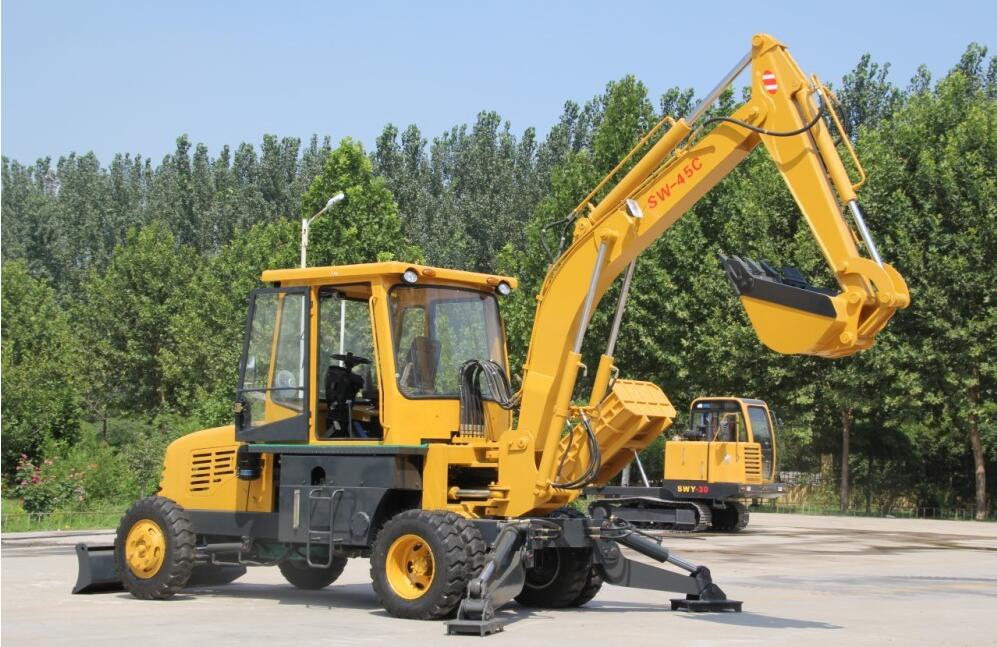Excavator classification

The ordinary excavator is driven by internal combustion engine and electric power. Electric excavators are mainly used in flammable and explosive places such as plateau hypoxia and underground mines.
According to different scales, excavators can be divided into large excavators, medium excavators and small excavators.
According to different walking modes, excavators can be divided into crawler excavators and wheel excavators.
According to different transmission modes, excavators can be divided into hydraulic excavators and mechanical excavators. Mechanical excavators are mainly used in some large mines.
According to the purpose, excavators can be divided into general excavators, mining excavators, marine excavators, special excavators and other different categories.
According to the bucket, excavators can be divided into front shovel excavator, backhoe excavator, dragline excavator and grab excavator. Backhoe excavators are mostly used to excavate materials above the surface, while backhoe excavators are mostly used to excavate materials below the surface.
1.Backhoe excavator
Backhoe type is the most common type we have seen. It is backward and downward, and it is forced to cut the soil. It can be used for excavation below the shutdown working face. The basic operation methods include: trench end excavation, trench side excavation, straight excavation, curve excavation, excavation at a certain angle, ultra-deep trench excavation and trench slope excavation.
2.Front shovel excavator
The shovel action form of the front shovel excavator. It is characterized by "moving forward and forcing soil cutting". The front shovel has large digging force and can dig the soil above the parking surface. It shall be used for dry foundation pit with excavation height of more than 2m, but ramp up and down must be set. The bucket of the front shovel is larger than that of the backhoe of the same level. Excavate Class I to III soil with water content no more than 27%, and cooperate with dump trucks to complete the whole excavation and transportation operation. It can also dig large dry foundation pits and mounds. According to the different excavation routes and the relative positions of the transport vehicles, the excavation methods of the front shovel excavator include the following two types: forward excavation and lateral unloading; Forward excavation and reverse dumping.
3.Dragline excavator
The dragline excavator is also known as the cable shovel excavator. Its excavation features are: "backward downward, self-weight cutting". It is applicable to the excavation of Class I and II soil below the parking lot ground. When working, use inertia force to throw the bucket out and dig further. The excavation radius and depth are larger, but not as flexible and accurate as the backhoe. Especially suitable for large deep foundation pit excavation or underwater excavation.
4.Grab shovel excavator
Grab excavator is also called grab excavator. Its excavation characteristics are: "straight up and straight down, cutting soil by its own weight". It is applicable to the excavation of Class I and II soil below the ground of the parking lot, and is usually used for the excavation of foundation pits and open caissons in soft soil areas. It is especially suitable for digging deep and narrow foundation pits, dredging old river courses, digging mud in water, or loading gravel, slag and other loose materials. There are two excavation methods: trench side excavation and positioning excavation. If the grab is made into strips, it can also be used to load ore blocks, debris, wood, etc. in the wood yard.
Most excavators today are full hydraulic full swing excavators. Hydraulic excavator is mainly composed of engine, hydraulic system, working device, walking device and electrical control device. The hydraulic system is composed of hydraulic pump, control valve, hydraulic cylinder, hydraulic motor, pipeline, oil tank, etc. The electrical control system includes monitoring panel, engine control system, pump control system, various sensors, solenoid valves, etc.
Hydraulic excavator is generally composed of working device, upper body and lower body. According to its structure and use, it can be divided into crawler type, tire type, walking type, full hydraulic type, half hydraulic type, full rotary type, non-full rotary type, general type, special type, articulated type, telescopic type and other types.
The working device is the device that directly completes the excavation task. It is articulated by the boom, stick and bucket. In order to meet the needs of various construction operations, hydraulic excavators can be equipped with various working equipment, such as excavation, lifting, loading, leveling, clamps, bulldozers, impact hammers, rotary drills and other working tools.
The rotary walking device is the main body of the hydraulic excavator, and the upper part of the turntable is equipped with a power device and a transmission system. The engine is the power source of hydraulic excavator. Most diesel engines can be used in convenient places, and electric motors can also be used.
The hydraulic transmission system transmits the power of the engine to the hydraulic motor, hydraulic cylinder and other actuating elements through the hydraulic pump to push the working device to move, thus completing various operations.





















